|
|
Baptisia australis (blue false indigo) is the Perennial Plant Association’s 2010 Perennial Plant of the Year. This long-lived native North American species is common to prairies and meadows. Walters Gardens in Zeeland, Mich., said the plant is easy to grow and is an interesting plant year-round. The shrub-like plants reach 3-4 feet tall and wide and can be used as a specimen plant or placed in small groupings. In mid- to late spring it produces 12-inch long spires of indigo blue flowers above the plant’s soft trifoliate blue-green foliage. The spent flowers are replaced by 2-3 inch long, puffy green seed pods. These pods turn black as they ripen in the summer and early fall and remain on the plants into winter. The pods can be dried for use in floral arrangements. Plants are hardy to USDA Hardiness Zones 3-9. For more: Walters Gardens, (888) 925-8377, www.waltersgardens .com |
 Spent flowers are replaced by puffy green seed pods that turn black as they ripen and remain on the plants into winter. Spent flowers are replaced by puffy green seed pods that turn black as they ripen and remain on the plants into winter. |
|

Explore the August 2009 Issue
Check out more from this issue and find your next story to read.
Latest from Greenhouse Management
- Agastache mexicana Summerlong Lemon
- Trump threatens 25% tariffs on Mexico and Canada in move that could hurt horticulture
- Storm watch
- Meet the All-America Selections AAS winners for 2025
- AmericanHort accepting applications for HortScholars program at Cultivate'25
- A strong foundation
- BioWorks hires Curt Granger as business development manager for specialty agriculture
- 2025 Farwest Show booth applications now open







